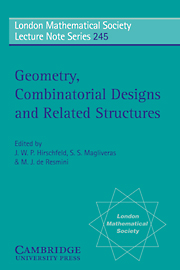Book contents
- Frontmatter
- Contents
- Preface
- Introduction
- On maximum size anti-Pasch sets of triples
- Some simple 7–designs
- Inscribed bundles, Veronese surfaces and caps
- Embedding partial geometries in Steiner designs
- Finite geometry after Aschbacher's Theorem: PGL(n, q) from a Kleinian viewpoint
- The Hermitian function field arising from a cyclic arc in a Galois plane
- Intercalates everywhere
- Difference sets: an update
- Computational results for the known biplanes of order 9
- A survey of small embeddings for partial cycle systems
- Rosa triple systems
- Searching for spreads and packings
- A note on Buekenhout-Metz unitals
- Elation generalized quadrangles of order (q2, q)
- Uniform parallelisms of PG(3, 3)
- Double-fives and partial spreads in PG(5, 2)
- Rank three geometries with simplicial residues
- Generalized quadrangles and the Axiom of Veblen
- Talks
- Participants
Finite geometry after Aschbacher's Theorem: PGL(n, q) from a Kleinian viewpoint
Published online by Cambridge University Press: 04 November 2009
- Frontmatter
- Contents
- Preface
- Introduction
- On maximum size anti-Pasch sets of triples
- Some simple 7–designs
- Inscribed bundles, Veronese surfaces and caps
- Embedding partial geometries in Steiner designs
- Finite geometry after Aschbacher's Theorem: PGL(n, q) from a Kleinian viewpoint
- The Hermitian function field arising from a cyclic arc in a Galois plane
- Intercalates everywhere
- Difference sets: an update
- Computational results for the known biplanes of order 9
- A survey of small embeddings for partial cycle systems
- Rosa triple systems
- Searching for spreads and packings
- A note on Buekenhout-Metz unitals
- Elation generalized quadrangles of order (q2, q)
- Uniform parallelisms of PG(3, 3)
- Double-fives and partial spreads in PG(5, 2)
- Rank three geometries with simplicial residues
- Generalized quadrangles and the Axiom of Veblen
- Talks
- Participants
Summary
Abstract
Studying the geometry of a group G leads us to questions about its maximal subgroups and primitive permutation representations (the G-invariant relations and similar structures, the base size, recognition problems, and so on). Taking the point of view that finite projective geometry is the geometry of the groups PGL(n, q), Aschbacher's theorem gives us eight natural families of geometric objects, with greater or smaller degrees of familiarity. This paper presents some speculations on how the subject could develop from this point of view.
Information
- Type
- Chapter
- Information
- Geometry, Combinatorial Designs and Related Structures , pp. 43 - 62Publisher: Cambridge University PressPrint publication year: 1997
